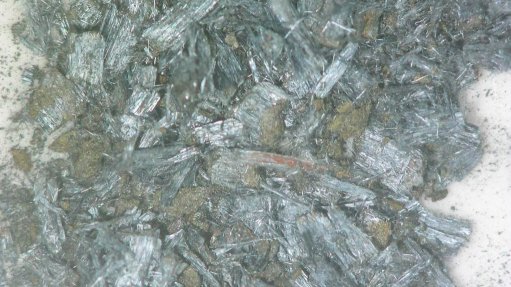
ASBESTOS MATERIAL The exposure of mineworkers, artisans and millers to the toxic asbestos material was poorly controlled, which resulted in many people contracting debilitating and often deadly diseases
South Africa was once one of the leading producers of asbestos, but mining this highly hazardous material has left a significantly negative legacy in the areas where it was once mined, asserts local minerals and metallurgical innovation company Mintek mineralogy department scientist Sonwabile Rameni.
He points out that the exposure of mineworkers, artisans and millers to the toxic asbestos material was poorly controlled, which resulted in many people contracting debilitating and often deadly diseases, such as cancer and asbestosis.
Rameni adds that downstream users of asbestos in the construction, renovation and demolition sectors also contracted ailments.
He adds that, “worse yet” is that the lives of people residing in former asbestos mining villages continue to be in danger, despite many of the mines having closed decades before most of these residents were born.
Although the last asbestos mine was closed in 2001, South Africa enacted legislation only in 2008, which banned the use of asbestos.
Additionally, Rameni notes that asbestos mine sites have been rehabilitated over the past ten years to mitigate their negative impacts.
However, he says the lack of adequate post-rehabilitation monitoring of these sites has been detrimental to ensuring that the sites remained fully rehabilitated.
Meanwhile, Rameni points out that Mintek, through a team of geologists and engineers, recently undertook a risk assessment of seven abandoned asbestos mines in and around the village of Mafefa, in Limpopo, on behalf the Department of Mineral Resources.
The team found several old asbestos mine adits and processing areas that were located near to rivers, homes and schools.
Secondary forms of asbestos contamination were discovered at the Sealane Primary School. On the playground, children continue to play in an old abandoned building structure, which was built using asbestos, despite a sign warning them not to.
At Kgalema Primary School, a building containing asbestos material is used as a staffroom for teachers. The school is aware of the matter, but cannot afford to demolish the structure and build a new one.
Rameni acknowledges that, despite the successful rehabilitation of more than 5 000 former asbestos sites in South Africa over the past ten years, government has to do more to ensure all the sites are rehabilitated and structures containing asbestos are demolished.
Rameni was a speaker at black-owned training and conferencing company Intelligence Transfer Centre’s EnviroMining conference, held in Johannesburg, in March.